3rd Place | Angolo Verde by Leslie Sadkowski
Contrary to its current state, the corner of Grand and Leavitt was not always abandoned; a few years ago, this area was bustling with customers looking for greenery to buy and take home from the garden shop. It was not until the local business moved elsewhere that the space began to deteriorate.The surrounding area consists of a mix of older, relatively unkempt buildings and newer homes, which also means there are vast differences in design. In this project, I decided to maintain some parts of the existing structures to embrace the older aspect of the neighborhood, while adding more modern elements, like large glass windows and solar technology on the roof of the main building. Furthermore, I hope that by combining new and old parts, this spatial change will seem gradual and not as disruptive as the recent changes as a result of gentrification. This building, unlike most in the area, takes advantage of natural lighting and other resources like gray water for the site's vegetation. Although the corner of Grand and Leavitt is not the only empty lot in the area—as it is joined by a lot across the street and two near Western Avenue—reducing unused spaces can decrease violence and beautify the street that leads downtown to Navy Pier. I particularly wanted to design a green, public space because the neighborhood lacks a connection to nature. Although Smith Park lies just northwest of this corner, along with a small garden at my former elementary school, these spaces simply "exist" and are not as interactive with residents. In contrast, this project takes time and community effort to maintain. This green corner, or "angolo verde," was made with the intention to be something more than just a space that exists—it is a space that is shared by a diverse community and connects them to nature in the city.Similar to the buildings in the area, some residents have seen generations grow up, while others have lived here for less than a year. These differences sometimes welcome subtle discord, but by reconstructing this space those feelings can dissolve and encourage people to embrace the community. People will hopefully care for more than just the front steps of their home and those they identify with by coming together to this area. The community building, for instance, could be used as a place to meet and discuss issues we all face, including violence and the empty lots that contractors want to turn into high rises.The main reason why I chose to illustrate my ideas through SketchUp was because it provided the most realistic representation of what I envisioned. I thought about my community and felt that if I were to present my idea to them, this would be the most clear visual representation. I also found that, seeing the two versions of Grand and Leavitt side-by-side, it inspires me to do more for the place in which I grew up and act upon those thoughts of progress.




